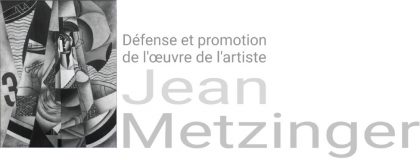Jean Metzinger Catalogue Raisonné

Number: AM-06-013 Jean Metzinger
Date: 1906
Title: Portrait of Delaunay
Medium: Oil (support unknown)
Dimensions: 64.8 x 53.3 cm
Inscriptions: Signed, inscribed and date 1906 on the reverse
Provenance: Sale, 2 December 1966, lot 20 (auction house and location pending further investigation)
Exhibitions: Salon d’Automne, 1906, Paris, no. 1191, titled Portrait de M. Robert D…, collection R. Delaunay
Galerie Art Vivant, Paris, Jean Metzinger, 40 peinture inédites de 1910 à 1952, 15 May – 15 June 1952, no. 6
Literature: Joann Moser, Daniel Robbins, Jean Metzinger in Retrospect, The University of Iowa Museum of Art, 1985, no. 9, reproduced p. 39
Notes: In 1906 Metzinger formed a close friendship with Robert Delaunay. Metzinger’s portrait of the young Robert Delaunay was realized a year before the two artists exhibited together at Berthe Weill’s gallery. This portrait, along with Delaunay’s Portrait of Metzinger, L’homme à la tulipe, was exhibited in Paris at the Salon d’Automne of 1906.
Unfortunately, all we have available at this time is this black and white half-tone reproduction of the work and a poor quality color quadrichrome CMYK (not shown). Structurally, the painting is solid, Delaunay’s cane offsetting his leftward stance, and the artwork represented behind (an exotic bird?) balancing to some extent the off-center position of the sitter.
The mosaic-like brushwork is a significant step beyond the Divisionism practiced by others at the time. The cuts are large and block-like. Rarely, if ever before had such a style been pushed to this extreme, and if it had, it was in the practice of Jean Metzinger himself, in works such as Bacchante (executed the same year).
Metzinger was an inductive painter. He constructed his whole from the sum of its parts. He worked wisely from the forehead to the eyes, continuing by way of his interests in mathematics. In the manner of a sculptor he built up his pictures as a complete whole, while balancing his masses he constructed. Sensibly, the face lights up on the background. The successive ‘cubes’ which enveloped it are laid bare and expose his thoughts.
But this simultaneous process left him quite unsatisfied, and he constantly reviewed his original plans. He lived for the creation to which he gave life. His work was an experiment, the result of a mysterious genius whose secret, pending a 1910 article and a 1912 publication (coauthored with Albert Gleizes), was not all told. What he knew before was the impression he expected to obtain, the story it would tell, what it would reveal of the subject and would express of the natural world, the fundamental nature underlying all things. And it is thus he approached those material things (a still life, a landscape, a model) which speak to us of an intense inner life. His plans evolve, he paints astonishing faces, quivering and mobile as he observes them.
In this work Metzinger was ably seconded by Delaunay… (Alexander Mittelmann, Jean Metzinger, Divisionism, Cubism, Neoclassicism and Post Cubism, written 2 May 2012)
Whereabouts unknown

